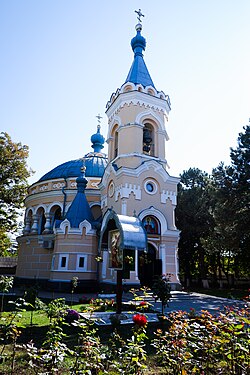You can help expand this article with text translated from the corresponding article in Romanian. (May 2010) Click [show] for important translation instructions.
|
This article needs additional citations for verification. (December 2020) |
Ungheni (Romanian pronunciation: [uŋˈɡenʲ]) is a municipality[2] in Moldova. With a population of 35,157, it is the seventh largest town in Moldova and the seat of Ungheni District.
Ungheni | |
|---|---|
 Alexander Nevsky Cathedral | |
| Coordinates: 47°13′N 27°49′E / 47.217°N 27.817°E | |
| Country | Moldova |
| County | Ungheni District |
| Area | |
| • Total | 16.4 km2 (6.3 sq mi) |
| Population | |
| • Total | 30,804 |
| • Density | 1,900/km2 (4,900/sq mi) |
| Time zone | UTC+2 (EET) |
| • Summer (DST) | UTC+3 (EEST) |
| Website | http://ungheni.md/ |
There is a bridge across the Prut and a border checkpoint to Romania. There is another border town with the same name in Romania (Ungheni, Iași), on the other side of the Prut River.
History edit
The first historical mention of Ungheni dates to 20 August 1462. A railway between Ungheni and Chișinău was built in 1875 by Russia in preparation for the Russo-Turkish War (1877–1878). After World War II, the rail route through Ungheni became the main connection between the USSR and Romania.
Features and attractions edit
Gustave Eiffel bridge edit
In 1876, after the spring flooding of the river Prut, the railway bridge that linked Moldova and Romania was almost destroyed. The Railways Department invited Gustave Eiffel to Bessarabia (Moldova) to redesign and rebuild the bridge. Today, it remains a strategic structure under the supervision of border guards.
Th EU proposed in 2023 to lay a new rail 1435mm standard gauge line from Ungheni to Chisinau, alongside the existing 1520mm track, to avoid disruption to existing services.[3]
Demographics edit
According to the 2014 census, the population of Ungheni amounted to 30,804 inhabitants (making it the sixth largest city in Moldova), a decrease compared to the previous census in 2004, when 32,530 inhabitants were registered. Of these, 14,647 were men and 16,157 were women.[4]
Ethnic composition of Ungheni (2014)[5]
Footnotes:
* There is an ongoing controversy regarding the ethnic identification of Moldovans and Romanians.
* Moldovan language is one of the two local names for the Romanian language in Moldova. In 2013, the Constitutional Court of Moldova interpreted that Article 13 of the constitution is superseded by the Declaration of Independence,[7] thus giving official status to the name Romanian.[8][9]
| Year | Pop. | ±% |
|---|---|---|
| 1959 | 11,129 | — |
| 1970 | 17,228 | +54.8% |
| 1979 | 25,792 | +49.7% |
| 1989 | 37,788 | +46.5% |
| 2004 | 32,530 | −13.9% |
| 2014 | 30,804 | −5.3% |
Media edit
- Unghiul
- Expresul de Ungheni
- Euronova TV
- UNGHENI.TV
- Radio Chişinău 93.8 FM
- Vocea Basarabiei 100.1 FM
Natives edit
International relations edit
Twin towns – Sister cities edit
Ungheni is twinned with:
Consulates edit
Gallery edit
-
The first historical mention of Ungheni dates to 20 August 1462
-
Ungheni river port
-
Mihai Eminescu statue
-
Socialist mosaics
-
Socialist mosaics
-
Socialist mosaics
References edit
- ^ Results of Population and Housing Census in the Republic of Moldova in 2014: "Characteristics - Population (population by communes, religion, citizenship)" (XLS). National Bureau of Statistics of the Republic of Moldova. 2017. Retrieved 1 May 2017.
- ^ LEGE Nr. 248 din 03.11.2016 pentru modificarea și completarea Legii nr. 764-XV din 27 decembrie 2001 privind organizarea administrativ-teritorială a Republicii Moldova (in Romanian)
- ^ "EIB study set out first steps for standard-gauge links to Ukraine and Moldova". 7 August 2023.
- ^ "2014 Moldova Census of Population and Housing". National Bureau of Statistics of the Republic of Moldova. (in Romanian, Russian, and English)
- ^ "2014 Moldova Census of Population and Housing". National Bureau of Statistics of the Republic of Moldova. (in Romanian, Russian, and English)
- ^ "2014 Moldova Census of Population and Housing". National Bureau of Statistics of the Republic of Moldova. (in Romanian, Russian, and English)
- ^ "Hotărâre Nr. 36 din 05.12.2013 privind interpretarea articolului 13 alin. (1) din Constituție în corelație cu Preambulul Constituției și Declarația de Independență a Republicii Moldova (Sesizările nr. 8b/2013 și 41b/2013)" (in Romanian). Constitutional Court of Moldova. Archived from the original on 5 March 2016. Retrieved 20 December 2013.
124. ... Prin urmare, Curtea consideră că prevederea conținută în Declarația de Independență referitoare la limba română ca limbă de stat a Republicii Moldova prevalează asupra prevederii referitoare la limba moldovenească conținute în articolul 13 al Constituției.
[124. ... Therefore, the Court considers that the provision contained in the Declaration of Independence regarding the Romanian language as the state language of the Republic of Moldova prevails over the provision regarding the Moldovan language contained in Article 13 of the Constitution.] - ^ "Moldovan court rules official language is 'Romanian', replacing Soviet-flavored 'Moldovan'". Fox News. Associated Press. 5 December 2013. Archived from the original on 9 December 2013. Retrieved 7 December 2013.
- ^ "Chisinau Recognizes Romanian As Official Language". Radio Free Europe/Radio Liberty. 5 December 2013. Archived from the original on 23 September 2016. Retrieved 11 March 2014.
- ^ Sister Cities Winston-Salem Archived 23 September 2015 at the Wayback Machine. City of Winston-Salem.
- ^ Winston-Salem, NC Archived 23 March 2017 at the Wayback Machine. Interactive City Directory. Sister Cities International, Inc.
- Brezianu, Andrei and Spânu, Vlad (eds.) (2007) "Ungheni" Historical Dictionary of Moldova (2nd ed.) Scarecrow Press, Lanham, Maryland, USA, p. 371, ISBN 978-0-8108-5607-3


